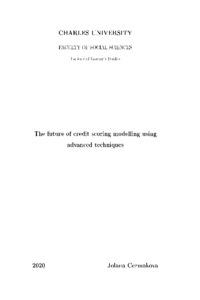The future of credit scoring modelling using advanced techniques
Budoucnost kreditního skóringu s pokročilými technikami
diplomová práce (OBHÁJENO)

Zobrazit/
Trvalý odkaz
http://hdl.handle.net/20.500.11956/117894Identifikátory
SIS: 213891
Kolekce
- Kvalifikační práce [17132]
Autor
Vedoucí práce
Oponent práce
Geršl, Adam
Fakulta / součást
Fakulta sociálních věd
Obor
Ekonomie a finance
Katedra / ústav / klinika
Institut ekonomických studií
Datum obhajoby
16. 6. 2020
Nakladatel
Univerzita Karlova, Fakulta sociálních vědJazyk
Angličtina
Známka
Výborně
Klíčová slova (česky)
Strojové učení, Kreditní hodnocení, Finanční odvětví, Úvěrové riziko, Prediktivní modelováníKlíčová slova (anglicky)
Machine learning, Credit scoring, Financial industry, Credit risk, Predictive modellingMachine learning, neboli strojové učení, se stává součástí každodenního života a má nepopiratelný vliv na celou řadu odvětví. Ve finančním odvětví tento dopad spočívá zejména v prediktivním modelování. Cílem této práce je popsat základní principy umělé inteligence, především její podmnožiny, strojového učení. Nejpoužívanější techniky strojového učení jsou v této práci nastíněny teoretickou i praktickou cestou. V rámci práce byly sestaveny čtyři praktické modely. Byly diskutovány výsledky a limitace každého z modelů a zároveň byly modely mezi sebou vzájemně porovnány na základě jejich indi- viduálních výkonů. Modelování bylo provedeno na reálných datech, poskyt- nutých společností Home Credit. Výsledný výkon metod, založených na strojovém učení a měřený pomocí metrik KS a GINI, byl bud' velmi srovn- atelný, nebo dokonce horší než výkon tradičně používané logistické regrese. Přesto mohl tento výsledek spočívat například v nedostatečném datovém souboru, v nesprávné přípravě dat, nebo v nevhodně použitých algoritmech, tedy ne nutně v samotných modelech.
Machine learning is becoming a part of everyday life and has an indisputable impact across large array of industries. In the financial industry, this impact lies particularly in predictive modelling. The goal of this thesis is to describe the basic principles of artificial intelligence and its subset, machine learning. The most widely used machine learning techniques are outlined both in a theoretical and a practical way. As a result, four models were assembled within the thesis. Results and limitations of each model were discussed and these models were also mutually compared based on their individual per- formance. The evaluation was executed on a real world dataset, provided by Home Credit company. Final performance of machine learning methods, measured by the KS and GINI metrics, was either very comparable or even worse than the performance of a traditional logistic regression. Still, the problem may lie in an insu cient dataset, in the improper data prepara- tion, or in inappropriately used algorithms, not necessarily in the models themselves.
